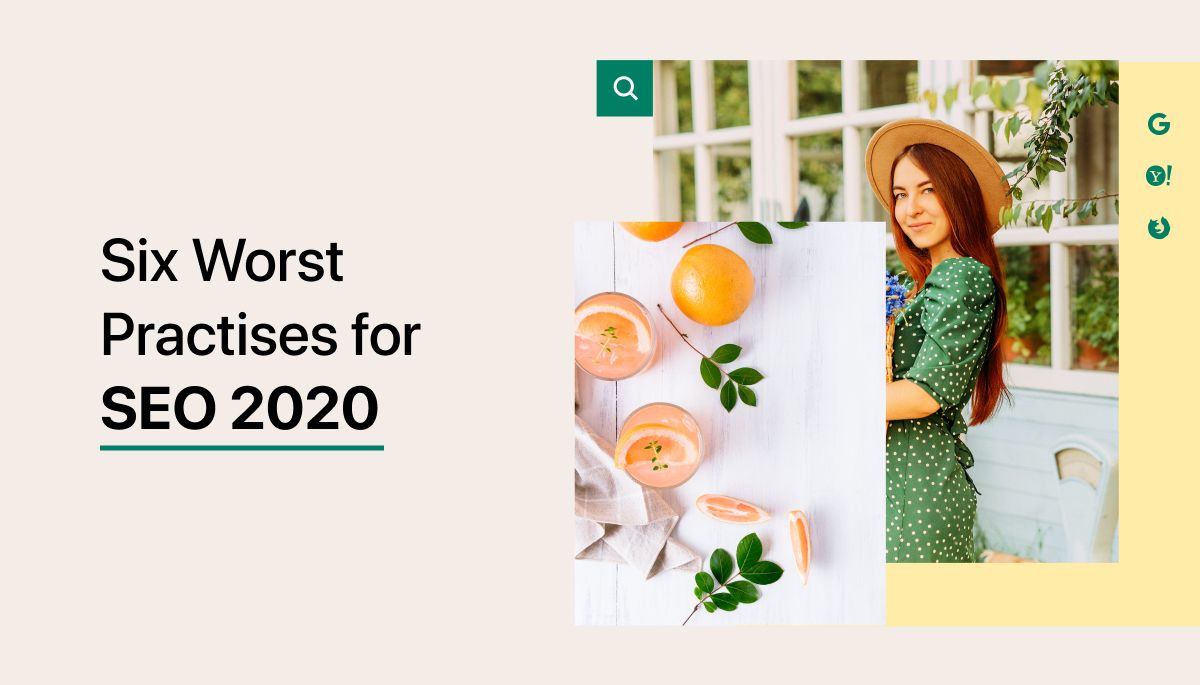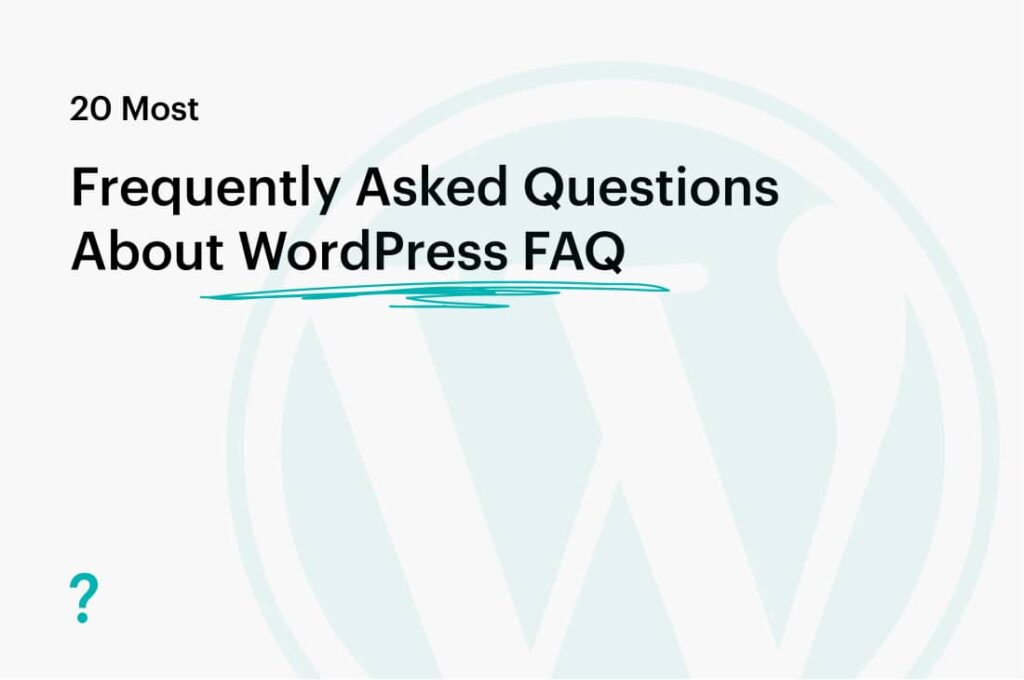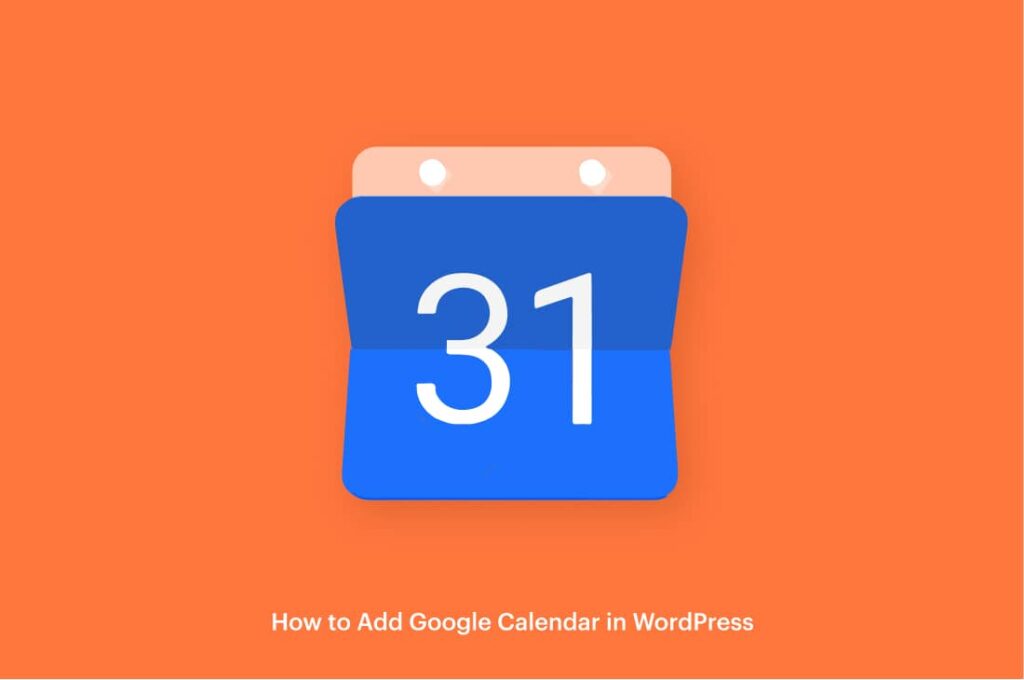Search Engine Optimization, which we will be referring to as SEO from now on, is one of the most important and pivotal factors of every website and every business that’s established their online presence. SEO has always been a mystery we were always trying to solve. And up to this day, the mystery remains partially unsolved.
The mystery remains mainly due to the constant changed and updated that Google performs to keep serving content and information that’s useful to the users. To keep up with the latest updates and regularly made changes in Google some might consider it a sport, it requires time and effort.
Being on the loop with the best practices will help your website perform better. But in the meantime, you should be informed of what SEO tactics you use to harm or damage your brand. Thus, this article aims to help identify some of the worst SEO practices that you must avoid.
Before we get into it, we have previously laid down the best practices on how to rank higher in Google search engine. With this article showing the worst SEO practices, you now have the Ying and the Yang of search engines. That shall help you optimize your website for better performance.
Playing by the Rules: White-Hat SEO
The White Hat SEO concept means that you will be following the rules from the book, no deviating, no loopholes, straight-on following the General Guidelines set out by Google.
White Hat SEO means to comply with any of the SEO practices to improve and proliferate your ranking in search engines, while in the meantime maintaining the integrity and acquiesce with all the rulebook set out by the search engine. This is the opposite of the worst SEO practices.
This is a long-term commitment, you can’t be expecting miracles the next day. When playing by the rules, you will be able to contribute to high-quality content and provide useful information for the users. Google appreciates that thus will rank you higher.
Uses of White Hat SEO will include:
- High-quality content will add to better user experience and will offer them in-depth information for their inquiry.
- Using all the right keywords that are sensible and on-brand.
- Fast loading time and mobile-friendly websites to appeal to every device.
- Visually striking websites with clean design and easy navigation display.
The list of the best SEO practices that White Hats use is long and needs more analysis than this, this is simply a sneak preview into the deep dive of search engines.
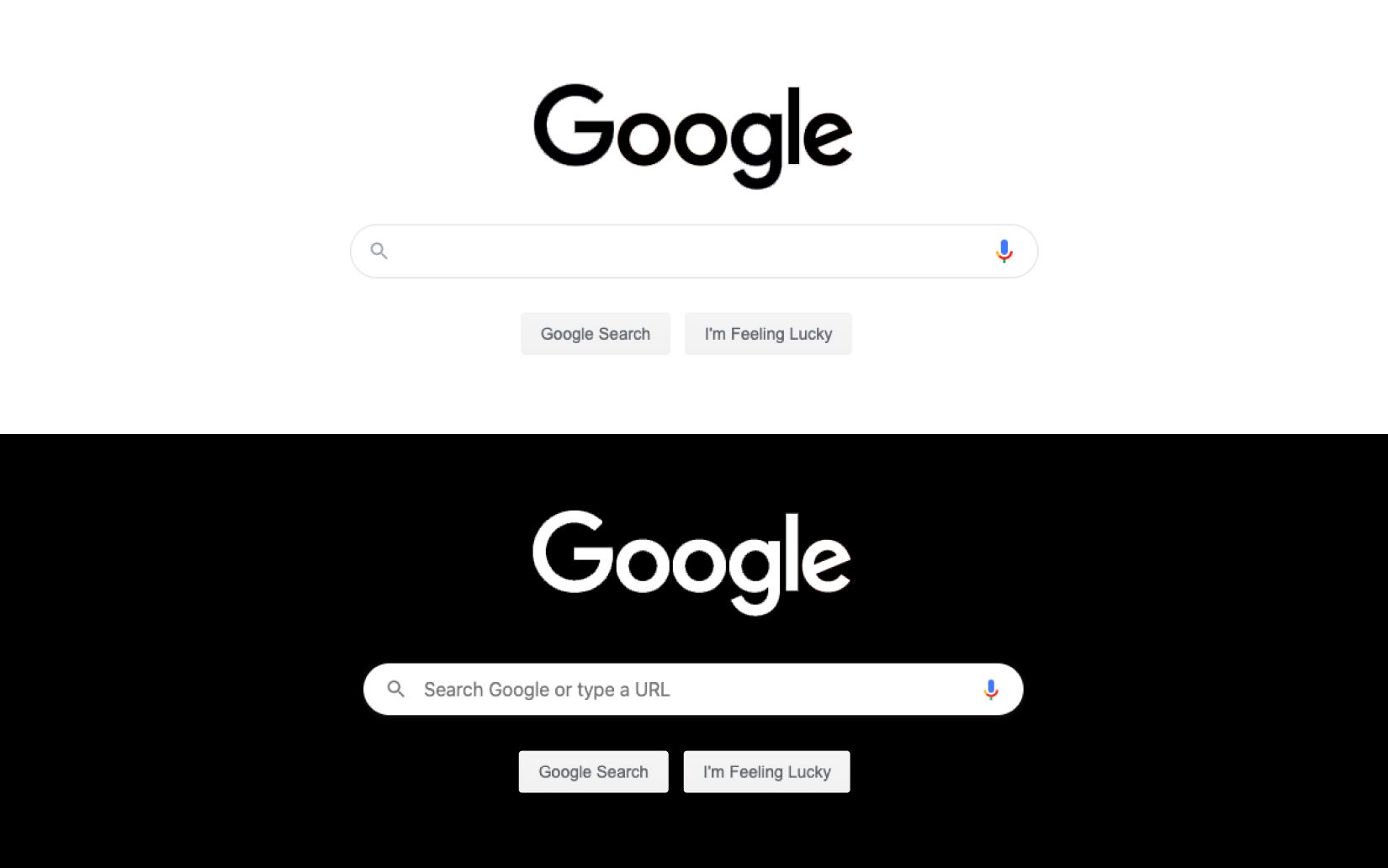
Taking the shortcut: Black Hat SEO
Black Hat SEO has the goal as White Hat SEO, ranking on top pages in search engines, but take different approaches. Black Hat SEO means bending the rules and guidelines set by the search engine, finding loopholes, and operating upon them.
Adherents of Black Hat will make use of strategies, techniques, and tactics that are against the rules, to some extend even being plain unethical. Black haters write content for search engines, not for humans. This type of content will be of no value to any inquiry or user, although they are ranked high.
Use of Black Hat SEO will include:
- Disobedience with the General Guidelines
- Provide content that optimized for search engine not human
- Keyword Stuffing
- Cloaking
It is intrinsic of this approach to exploit and find algorithm loopholes to operate upon them. Some of these “escapes” will go to the extent where they become unethical. Google constantly keeps an eye open for these types of contravening to punish the behavior. These worst SEO practices will help you identify the mistakes you might be doing while trying to reach the climbs of search engines.
Worst SEO practices
Now that we got the main concepts covered. We are going to go through the worst SEO practices that could damage your brand or your website. They will include the misguided use of keywords, the creation of two different versions of content, the good old quality vs quantity debate, and erratic posting content.
Keyword Stuffing
Keyword optimization is a crucial factor for the google bots to index your page and present it when the right user inquiry is matched. Keyword stuffing is considered one of the worst SEO practices as it does not provide value to the user and tries to “deceive” search engines.
Your content should be easy-to-read, comprehensible, and should follow a logical path. If it fails to do so, then it will be of no use to the users, and eventually, Google will no longer recommend it as a top solution.
Adding keywords just for the sake of page ranking is by no means a smart move, and it presents a outdated SEO practice that you should not follow. If you overemphasize the keyword and ignore your buyer persona and their solution, it means that people won’t care about the product or content you are trying to push forward.
Your content or product won’t be their solution, thus, you will decrease the chances of them coming back to your site. Cramping your content with keywords is not effective and will not produce quality content, which is a number one rule for Google, which we will go in detail later.
What should you do?
You should focus on staying within the lane, stay within your topic, and create relative content. Use the keyword strategically as a jumping-off point to make your statements clearer. Don’t push it! If the keyword does not come in naturally in a sentence don’t add it.
Watch out for the keyword density, although there is no golden rule to this, try matching 10x times the keyword for 500 words. Use variations and synonyms of the keyword as well, but again do it naturally, only when they don’t risk stringing on the sentences.
Duplicated Content
If I may refer to our previous article on how to rank high in Google, we have mentioned that content shall be unique and bring some new perspective to the subject. Duplicating content falls far away from that advice.
Copying someone’s content and pose it as yours is cheating, and what some in the academic world would call it plagiarism as well as the worst SEO practice you could follow. Beyond the culturally unethical act, this type of content will be denied by google simply because it already exists once, there is no need for another exact, cheap replica of that content.
To back up that duplicating content will be bad SEO practice for your website, we will introduce you to this study made by SEMRush that analyzed over 100.000 websites, and they mention that one of the most common on-page SEO error is duplicated content.
To make sure you stay on Google’s search engine good side, be aware that your content and meta descriptions should be unique and original.
What should you do
If you wish to quote or include part of the content that is taken elsewhere, then there should be proper credit established. And if you need to duplicate content, because it will be useful to your users, try adding the nofollow and noindex option to these pages, so that it does not hurt your SEO.
In many cases you might even duplicate your own posts and pages, this is especially prevalent in titles and meta descriptions, or in product pages that are very similar.
Although, this should be done reluctantly, only when needed and it is always best practice to change the slug of the duplicated post to differentiate it from the original one.
Cloaking
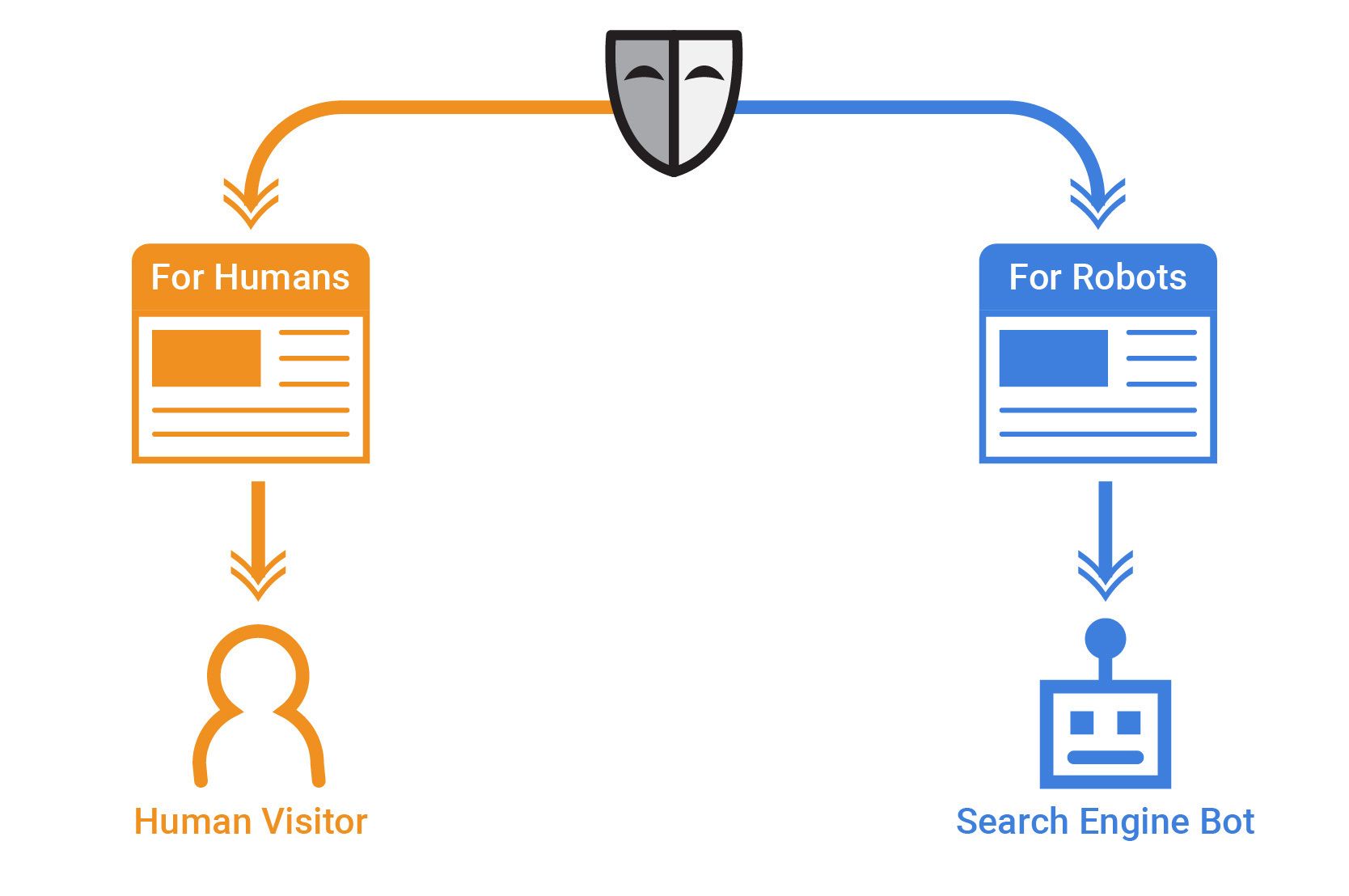
Clacking in the SEO world means creating and presenting two different versions of content to search engines and humans.
Each version will comprise what the recipient wants to see. It goes against Google’s policies and is considered one of the worst SEO practice because users will be presented with material other than they expect.
Spamdexing is a concept in digital marketing and in online advertising that refers to premeditated manipulation of search engine indexes. Any type of this kind of behavior is condemned and is considered to be a harmful SEO practice due to Google’s penalties.
If you choose to go down this road the consequences will be harsh accordingly, you could even get a permanent ban from Google. This type of SEO practice is done mainly by those who are more skillful and know their way around code., but it’s still on the worst SEO practices list.
What should you do?
Tailoring your content to appeal to different targeted groups is acceptable, as long as you are not changing the content to appeal to search engine crawlers.
For instance, you will need to change the page layouts that will match every device, resize the images, and the content to look beautifully on mobiles and tablets.
You will change the language of your website based on your targeted users, and that is totally fine to do. Alternatively, a publisher might change the ads content to fit different profiles or fund their website, that too is completely fine and is considered a good SEO practices because you are omni channeling your content.
Just as long as you don’t change the content merely to confuse or deliberately manipulate the search engine bots. That goes against all rules.
Content Quality vs Content Quantity
We will go back to the ever-discussed quality vs quantity debate. Just a heads up Google will require both. Content quality and content quantity go hand in hand. To get ranked higher in search engines, you will need to add value to your content.
The evaluation of content quality is conducted by some search quality evaluators that crawl the page and determine the quality from a human point of view. According to Google’s General Guidelines, characteristics of quality content include:
- A high level of E-A-T ( Expertise, Authoritativeness, and Trustworthiness)
- A satisfying amount of main content
- Reach the intended purpose and more
Qualitative websites also require time for research and to give a fully detailed content that explains the topic from all standpoints. This means your content will get larger, adding to the quantity of content.
Qualitative content will only get you halfway. When combined with a large content that fully completed its intent will give you the best of results. High-qualitative long-form content will be an indicator and a great SEO practice to reserve that number one spot in Google.
BuzzSumo conducted the research and analyzed more than 100 million articles, and among the conclusions was that long-form content was the most shared posts.
What should you do?
Longer content will dive deeper into the topic and will provide a better solution to the user. This type of content will provide a comprehensive answer to the user’s inquiry, something that Google considers as great SEO practice.
Do not compromise the quality of your content, do your research, and never post just for the sake of posting. Engage in your writing and be passionate about it.
Inconsistent Posting
Inconsistent and erratic posting is a no-no in SEO. You should maintain professionalism in your content quality as well as content distribution.
If you go back and forth posting every now and then, you are damaging your website’s reputation, and you won’t be able to steadily increase your credibility with fresh and comprehensive content.
Inconsistent posting is a bad SEO tactic because you won’t be providing Google with new, valuable content and will loose on the opportunity to rank higher for more keywords and with more pages indexed.
If you plan on running your marketing strategy around your blog, or if you expect leads from your blog then you should always provide new content and create to the users the habit of expecting content regularly.
What should you do?
You could try and create a schedule for your blog, or content. You could write content daily, twice a week, weekly, monthly. Although posting monthly is not recommended.
This SEO practice falls close to the lane of qualitative content, where you don’t want to bargain content excellence to post regularly.
Stick to a schedule that works for you, where you have the freedom to write the content of value and posting that content to a deadline.
You can create a habit of people expecting your content let’s say Monday, and if you fail to fulfill their expectations, you will lose their trust.
Find the perfect balance where you can write top-notch qualitative content and do it on a consistent basis. Although not the worst SEO practice, consistence is always the best thing for a website on every aspect.
Leaving your Content Unmaintained
I know it might be annoying to go back to your old content, but it is an SEO practice everyone should perform. Things change and updates occur, ideally, your content should be evergreen, it should provide value over its lifetime.
But not all your content will stand its time, and it is for the best to optimize this type of content that undergoes development. Content that is left unmaintained will be rated the lowest because they will fail to achieve their purpose and become outdated, all due to lack of perpetuation, thus being considered as a bad SEO practice.
Search engines will favor content that’s new and fresh hence the inconsistent posting as a damaging SEO practice. Alternatively, the failure of a post could be attributed to wrongfully executed content.
It could be that your older content did not fulfill your buyer persona, not your targeted group, or it was simply badly written, thus performing badly. This will risk even your best content because it could drag down the site’s reputation.
What should you do?
You could start off by identifying the content that’s outdated or poorly written and you could either change its status to unpublished. Or you can go back and revise the content entirely.
You must audit your content and divide what that content does for you? Does it help you? Does it harm you? Or it simply does nothing to your website. Evaluate the quality of your content using the E-A-T system. Define whether it provides quality, value, it reaches the targeted audience.
Then decide whether you want to delete that content or you want to update. If you see that certain content is outdated but still brings traffic, a smart move would be to update it.
Lack of Internal Linkings
Next up on the worst SEO practices we also have the negligence of content creators to link to their own articles, we’ve always stated the linking is a crucial part of ranking better on search engines because it creates trust in your content and makes you an authority on your niche. This signals search engines that your content is worthy.
If you link internally within your website, you will be able to reduce the bounce rate, as you will be navigating users on various types of content that sit inside your website, thus piquing their curiosity on your site.
This correlates with another worst SEO practice we mentioned, posting inconsistently. If users have already loved your previous content, they hope to be back and read some more. If they find that the last article you wrote was 1 or 2 months ago, chances are they won’t come back.
What should you do?
When you are establishing a blog, or a content type piece of the website, it is always of best practice to write about similar topics that correlate to one another. You can link to all of your articles internally as you have already covered a wide range of topics and subtopics that naturally connect, and it won’t be intrusive for the user.
Citing and linking to posts around the same idea is always useful. Because this way users can obtain all the information they need around a topic without them ever leaving your website.
Not attending technical errors
Now we jump on the more technical side of SEO. Keyword research, quality content, social media strategies, or backlink development can all be highly effective for ranking better on search engines, but you must never forget the technical side of your website.
When we mention technical errors we comply with the updates of a website or server that you have immediate control over and that will directly or indirectly be linked to search engine ranking, indexation, and crawlability. This will include components like page titles, meta descriptions, alt tags, XML sitemaps, and other small but very important issues.
Leaving these issues unattained will cause your website to suffer in rankings. When Google spots those technical; issues it sends an alarm that the website will not provide a valuable user experience.
What should you do?
You should always include the title tags, the metadata, alt text in your blog posts as these are the indicators of what your blog post is primarily about. Setting up your website’s XML sitemap will provide a better structure f your website to Google.
It provides clear navigation between pages, all while behind-the-scenes structuring your content properly. Fixing the technical errors on your website will prove to be effective and will show a healthy website that offer great content and amazing user-experience.
Paid Links
It is a known fact that there is no shortcuts with Google. If you think you are going to rank number one in search engines, you are wrong. It takes time, hard work, and patience. We know that backlinks are a sure way to the top, but everything needs to be done naturally.
It is one of the worst SEO practices to attempt to buy links for the sake of better ranking. Google strongly goes against webmasters buying links, because this does not create a real and valuable authority.
It is all about connecting people to relevant content, so buying your way to the top of SERP is considered a form of cheating both Google crawlers and its users. Google usually applies penalties against sites that are using such an approach and you might see yourself at the end of the Google slum once you’ve been caught.
What should you do?
Instead of opting ro bad SEO practices like buying links, webmasters should focus on their content and create natural link building. As the name suggests, natural link building is backlinks that are created naturally, without webmasters having to pay or generate them either as guest posting or other forms of link building.
In order to create natural links, webmasters should follow the best SEO practices like consistent writing, quality content, social media share as they will provide a direct impact on natural link building. Simply focus on creating amazing content that will be useful and informative to your readers.
Failing to connect to your audience
You might have followed all the best practices for writing great and qualitative content, but a big part of SEO is also people finding out about your content. Having the find your website. It is imperative that you connect to the right audience, if you fail to do so then, this is also part of the worst SEO practices as it does not generate new leads, thus any traffic.
A big part of SEO is also having a steady strategy in place for reaching and connecting your targeted audience. Once you get to know your audience you will be able to produce quality content for them, as you know their behavior.
Google tries to provide only the best content for their users, so if your content does not answer their questions and as a result it wont rank well.
What should you do?
Connect to your audience through your content, make sure you are producing content that they can acquire and that they find helpful. Answer their questions, provide a solution for their issues.
Also make sure to share your content through all your social media accounts, newsletters. But that’s not all, sharing your content through these channels will only bring your content to a limited number of users.
Invest into successful promoting paid campaigns, use targeted sharing keyword tags. You will need to promote your content so that it reaches a wider audience, which is the main goal of your website.
Final Thoughts
SEO is a school in its self, you will need to be constantly updated with the latest issues and launches. It can be easy to lose yourself in these bad habits, just make sure you find time to review regularly your SEO strategy and what’s the best SEO practice you would overpower.
It is of vital importance knowing what will harm and damage your website, also be on the loop with the worst SEO practices, so that you start improving and stop the destructive habits. It could penalize you and your website, and that would be a downside for your site.
On the other hand, if you continue to follow the tactics you will notice its compound effects and see the growth of your website. Make sure to keep quality and consistency as the best characteristics, stray away from manipulative tactics that will offer fast results, they are proven to be destructive with time.
Follow all the best SEO practices to fuel more traffic and engagement and proliferate your success.
